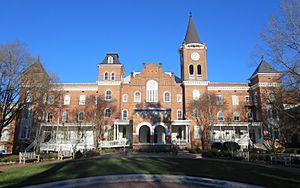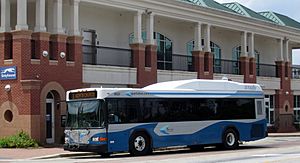Spartanburg, South Carolina facts for kids
Quick facts for kids
Spartanburg
|
|||
|---|---|---|---|
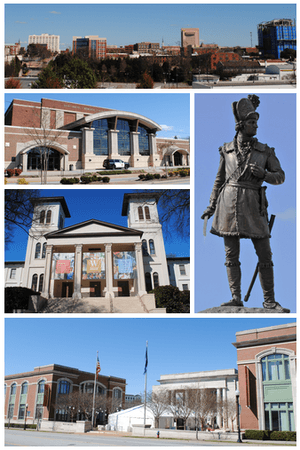
Top, left to right: Spartanburg skyline, Spartanburg Memorial Auditorium, Wofford College, Daniel Morgan Monument, Chapman Cultural Center
|
|||
|
|||
| Nickname(s):
The Hub City, Sparkle City, The Burg
|
|||
| Motto(s):
"Always Doing"
|
|||
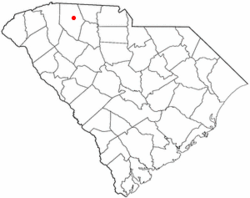
Location in South Carolina
|
|||
| Country | |||
| State | |||
| County | Spartanburg | ||
| Founded | 1787 | ||
| Incorporated | 1831 | ||
| Named for | The Spartan Regiment | ||
| Area | |||
| • Total | 20.37 sq mi (52.75 km2) | ||
| • Land | 20.25 sq mi (52.46 km2) | ||
| • Water | 0.11 sq mi (0.29 km2) 0.54% | ||
| Elevation | 797 ft (243 m) | ||
| Population
(2020)
|
|||
| • Total | 38,732 | ||
| • Estimate
(2023)
|
39,040 | ||
| • Rank | 11th in South Carolina | ||
| • Density | 1,912.41/sq mi (738.37/km2) | ||
| • Urban | 196,943 (US: 198th) | ||
| • Urban density | 1,088.1/sq mi (420.1/km2) | ||
| • Metro | 383,327 (US: 144th) | ||
| Demonym(s) | Spartans | ||
| Time zone | UTC−05:00 (Eastern) | ||
| • Summer (DST) | UTC−04:00 (Eastern) | ||
| ZIP Codes |
29301–29307, 29316, 29319
|
||
| Area codes | 864, 821 | ||
| FIPS code | 45-68290 | ||
| GNIS feature ID | 1250982 | ||
Spartanburg is a city in South Carolina, United States. It is the main city and county seat of Spartanburg County. In 2020, about 38,732 people lived there, making it the 11th largest city in the state.
Spartanburg is often called "The Hub City" because many railroad lines used to spread out from it like spokes on a wheel. It is also known as "Sparkle City" and "The Burg." The city is part of a larger area in northwestern South Carolina called "The Upstate."
The city is home to several colleges and universities, including Wofford College and Converse University. It is also where the company Denny's has its main office.
Contents
History of Spartanburg
Spartanburg was created in 1785. It was named after the Spartan Regiment, a local group of soldiers who fought in the American Revolutionary War. This group took part in the Battle of Cowpens, which happened nearby.
In 1831, Spartanburg officially became a city. In the late 1800s and early 1900s, it became a major center for making textiles (cloth). Around 40 textile mills were built in the area.
During World War I, a large training camp called Camp Wadsworth was in Spartanburg. It trained 100,000 soldiers. Later, during World War II, Camp Croft was used to train soldiers. This area is now Croft State Park.
By the 1950s, many textile jobs moved to other countries. This caused the mills in Spartanburg to decline.
Geography and Climate
Spartanburg covers about 20.37 square miles (52.75 km²). Most of this area is land, with a small amount of water.
Climate in Spartanburg
Spartanburg has a humid subtropical climate. This means it has long, hot, and humid summers. Winters are usually cool to mild.
The average temperature each year is about 61.6°F (16.4°C). In summer (June to September), high temperatures are usually in the 80s or low 90s °F (20s to 30s °C). In winter, average highs are around the mid-50s °F (10s °C). Spartanburg gets a good amount of rain throughout the year but very little snow.
| Climate data for Spartanburg, South Carolina (1991–2020 normals, extremes 1983–present) | |||||||||||||
|---|---|---|---|---|---|---|---|---|---|---|---|---|---|
| Month | Jan | Feb | Mar | Apr | May | Jun | Jul | Aug | Sep | Oct | Nov | Dec | Year |
| Record high °F (°C) | 79 (26) |
82 (28) |
90 (32) |
94 (34) |
96 (36) |
102 (39) |
106 (41) |
106 (41) |
98 (37) |
99 (37) |
84 (29) |
80 (27) |
106 (41) |
| Mean daily maximum °F (°C) | 54.1 (12.3) |
58.5 (14.7) |
66.0 (18.9) |
74.8 (23.8) |
81.0 (27.2) |
87.0 (30.6) |
90.1 (32.3) |
88.3 (31.3) |
83.4 (28.6) |
74.4 (23.6) |
63.8 (17.7) |
55.8 (13.2) |
73.1 (22.8) |
| Daily mean °F (°C) | 42.8 (6.0) |
46.1 (7.8) |
52.9 (11.6) |
61.1 (16.2) |
68.5 (20.3) |
75.8 (24.3) |
79.3 (26.3) |
78.1 (25.6) |
72.5 (22.5) |
61.7 (16.5) |
51.1 (10.6) |
44.7 (7.1) |
61.2 (16.2) |
| Mean daily minimum °F (°C) | 31.5 (−0.3) |
33.8 (1.0) |
39.8 (4.3) |
47.3 (8.5) |
56.0 (13.3) |
64.6 (18.1) |
68.6 (20.3) |
67.8 (19.9) |
61.6 (16.4) |
49.0 (9.4) |
38.4 (3.6) |
33.6 (0.9) |
49.3 (9.6) |
| Record low °F (°C) | −5 (−21) |
6 (−14) |
12 (−11) |
22 (−6) |
29 (−2) |
37 (3) |
51 (11) |
46 (8) |
35 (2) |
23 (−5) |
13 (−11) |
0 (−18) |
−5 (−21) |
| Average precipitation inches (mm) | 4.34 (110) |
3.77 (96) |
4.81 (122) |
4.29 (109) |
3.92 (100) |
4.58 (116) |
3.97 (101) |
4.56 (116) |
3.65 (93) |
3.93 (100) |
3.72 (94) |
4.70 (119) |
50.24 (1,276) |
| Average snowfall inches (cm) | 0.4 (1.0) |
0.0 (0.0) |
0.2 (0.51) |
0.0 (0.0) |
0.0 (0.0) |
0.0 (0.0) |
0.0 (0.0) |
0.0 (0.0) |
0.0 (0.0) |
0.0 (0.0) |
0.0 (0.0) |
0.2 (0.51) |
0.8 (2.0) |
| Average precipitation days (≥ 0.01 in) | 9.3 | 8.2 | 9.5 | 8.0 | 7.9 | 9.2 | 9.3 | 8.4 | 6.6 | 6.2 | 7.1 | 9.1 | 98.8 |
| Average snowy days (≥ 0.1 in) | 0.1 | 0.0 | 0.1 | 0.0 | 0.0 | 0.0 | 0.0 | 0.0 | 0.0 | 0.0 | 0.0 | 0.2 | 0.4 |
| Source: NOAA | |||||||||||||
People and Population
| Historical population | |||
|---|---|---|---|
| Census | Pop. | %± | |
| 1850 | 1,176 | — | |
| 1860 | 1,216 | 3.4% | |
| 1870 | 1,080 | −11.2% | |
| 1880 | 3,253 | 201.2% | |
| 1890 | 5,544 | 70.4% | |
| 1900 | 11,395 | 105.5% | |
| 1910 | 17,517 | 53.7% | |
| 1920 | 22,638 | 29.2% | |
| 1930 | 28,723 | 26.9% | |
| 1940 | 32,249 | 12.3% | |
| 1950 | 36,795 | 14.1% | |
| 1960 | 44,352 | 20.5% | |
| 1970 | 44,546 | 0.4% | |
| 1980 | 43,826 | −1.6% | |
| 1990 | 43,467 | −0.8% | |
| 2000 | 39,673 | −8.7% | |
| 2010 | 37,013 | −6.7% | |
| 2020 | 38,732 | 4.6% | |
| 2024 (est.) | 39,606 | 7.0% | |
| U.S. Decennial Census 2020 |
|||
Population in 2020
In 2020, Spartanburg had 38,732 people living in 15,154 households. About 8,638 of these were families.
Population in 2010
In 2010, there were 37,013 people in Spartanburg. The city had 15,989 households. About 28.9% of households had children under 18. The average household size was 2.33 people.
The median age in the city was 35 years old. About 25.2% of the population was under 18.
Economy and Jobs
Spartanburg's downtown area has been improved a lot recently. Many old buildings have been fixed up. New businesses and company offices have moved downtown.
Many large companies have offices in Spartanburg. These include Denny's, KYMCO, and Milliken & Company. The BMW car factory, located nearby in Greer, South Carolina, also helps the economy. It employs many people.
Main Employers
Here are some of the biggest employers in Spartanburg:
| # | Employer | # of employees |
|---|---|---|
| 1 | Spartanburg Regional | 9,648 |
| 2 | Spartanburg County | 1,515 |
| 3 | Spartanburg School District 7 | 1,273 |
| 4 | RedSail Technologies, LLC | 485 |
| 5 | Wofford College | 421 |
| 6 | City of Spartanburg | 416 |
| 7 | Spartanburg Hospital for Restorative Care | 300 |
| 8 | Converse University | 260 |
| 9 | Denny's Corporate Office | 250 |
| 10 | Advance America, Inc. | 233 |
Arts and Culture
Spartanburg has many places for arts and culture:
- Chapman Cultural Center: This center is a hub for history, art, theater, dance, music, and science. It has the Spartanburg Art Museum, History Museum, Science Center, and more.
- Converse University: This university is known for its music and visual art programs. It hosts many events for the community. Twichell Auditorium, on campus, is home to the Greater Spartanburg Philharmonic Orchestra.
- Hub City Writers Project: This group is a local publishing company and bookstore.
- Spartanburg County Public Library: The main library has a large collection of books and other materials. It also hosts meetings, concerts, and presentations.
- Spartanburg Memorial Auditorium: This auditorium has hosted many famous performers and shows. It was built in an Art Deco style and was updated around 2002.
- Wofford College: This college has been growing its arts programs. It offers creative writing, theater, and studio art.
Fun Places to Visit
- Cottonwood Trail: A walking trail in the Edwin M. Griffin Nature Preserve. It runs along Lawson's Fork Creek and is great for cycling, jogging, and walking. You can see wildlife like deer and wild turkeys here.
- Hatcher Garden and Woodland Preserve: A beautiful garden and woods in the middle of the city. It was created from an eroding gully and is now a home for birds and other animals.
- Magnolia Street Train Depot: One of Spartanburg's older buildings. It reminds people of the city's "Hub City" nickname. It now houses the Amtrak station, the Hub City Railroad Museum, and the Hub City Farmers' Market.
- Morgan Square: This is the main downtown area. It was the original courthouse village. A statue of Daniel Morgan, a general from the American Revolution, stands here.
- Walnut Grove Plantation: An 18th-century farmhouse preserved by the Spartanburg County Historical Association. It was the site of a skirmish during the American Revolutionary War.
Spartanburg was once known as the "Lowell of the South" because of its many cotton mills. These mills used the power of local rivers. Many old mill buildings still stand along the rivers.
- Beaumont Mill: North of downtown, this mill has been bought by Spartanburg Regional Healthcare.
- Converse Mill: Located east of the city. It was rebuilt in 1903 after a flood.
- Glendale Mill: Southeast of the city. Even though it burned in 2004, some parts remain. The old company store is now the Wofford College Environmental Studies Center.
Events and Attractions
- Dickens of a Christmas: A Victorian holiday event held downtown every year after Thanksgiving.
- The Greek Festival: A street festival in September with Greek food and cultural activities.
- Festifall: A historical celebration at Walnut Grove Plantation in October.
- The Hub City Farmers Market: An outdoor market held on Saturday mornings from April to December. It sells local produce.
- The Hub City Hog Fest: An annual barbecue festival and competition downtown.
- The International Festival: An event in October that celebrates cultures and foods from around the world.
- Music on Main: A street concert series held every Thursday from April to August.
- Red, White and Boom: A Fourth of July event with patriotic music and fireworks.
Sports
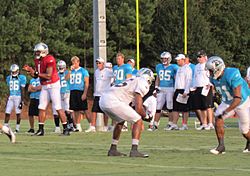
The Carolina Panthers NFL team used to hold their training camp at Wofford College from 1995 to 2023. They moved their camp to Charlotte in 2024.
Duncan Park Stadium is one of the oldest baseball stadiums in the country. It has been home to several minor league baseball teams. It is now the home field for Spartanburg High School's baseball teams.
The Shrine Bowl of the Carolinas is a high school football all-star game held each year at Wofford's Gibbs Stadium. It features top players from South Carolina and North Carolina.
Spartanburg is also home to Upward Sports, a Christian-based sports organization for kids.
The Down East Wood Ducks baseball team will move to downtown Spartanburg in April 2025. They will be renamed the Hub City Spartanburgers.
Government
Spartanburg has a city manager form of government. The mayor, Jerome Rice (elected in 2021), and six city council members make decisions together. The city council chooses a city manager who handles the daily running of the city.
The city offices are currently located at 187 W Broad Street. A new building for both city and county offices is being built.
Education
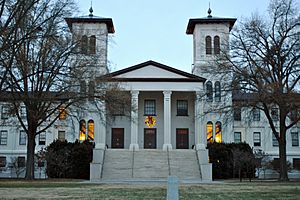
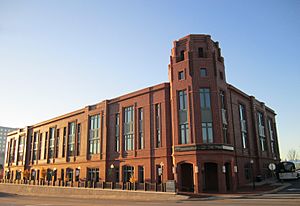
Spartanburg is a college town with several places for higher education:
Colleges and Universities
- Spartanburg Community College Downtown Campus
- Converse University: Founded in 1889, this is a comprehensive doctoral institution.
- Edward Via College of Osteopathic Medicine (VCOM) – Carolinas Campus: Classes started here in 2011.
- Wofford College: Founded in 1854, Wofford is a liberal arts college with about 1,500 students.
Other colleges in the area include:
- University of South Carolina Upstate (in Valley Falls)
- Spartanburg Community College (main campus in Southern Shops)
- Spartanburg Methodist College (in Saxon)
- Sherman College of Chiropractic
Schools for Younger Students
Most public schools in Spartanburg are part of Spartanburg County School District 7. Students in this district usually go to Spartanburg High School. Some parts of the city are served by Spartanburg County School District 6.
The South Carolina School for the Deaf and the Blind has its main campus near Spartanburg. There are also several private schools in the area, such as Spartanburg Christian Academy and Spartanburg Day School.
Media
Spartanburg has several newspapers and is part of a large television market.
- The Post and Courier: This newspaper from Charleston has an office in Spartanburg.
- Spartanburg Herald-Journal: This is Spartanburg's main newspaper.
- The Spartan Weekly News: This paper covers news and community events in Spartanburg County.
Spartanburg is part of the Greenville-Spartanburg-Anderson-Asheville TV market. This is one of the largest TV markets in the country.
Television channels serving the area include:
- WYFF 4 (NBC)
- WSPA 7 (CBS)
- WLOS 13 (ABC)
- WHNS 21 (Fox)
- WYCW 62 (The CW Network)
Transportation
Major Roads
Many major highways pass through or near Spartanburg, connecting it to other cities.
Public Transportation
The Spartanburg Area Regional Transit Agency (SPARTA) provides bus service in the city and nearby areas. Their buses have bike racks. The SPARTA Passenger Center is also a stop for Greyhound buses.
Spartanburg County also has a Dial-A-Ride service for door-to-door transportation.
Walking and Biking
Spartanburg has the Daniel Morgan Trail System, also called "the Dan." This system has 55 miles of paved and unpaved paths, sidewalks, and bike lanes. The Hub City Hopper, a special bike lane downtown, was named one of the best new U.S. bike lanes in 2023.
Airports
The Greenville-Spartanburg International Airport (GSP) is near Spartanburg and serves both Greenville and Spartanburg. It is one of the busiest airports in South Carolina.
The Spartanburg Downtown Memorial Airport (SPA) is a smaller airport for general aviation.
Train Station
Amtrak's Crescent train stops in Spartanburg. This train connects Spartanburg to major cities like New York, Washington, D.C., Atlanta, and New Orleans. The Amtrak station is at 290 Magnolia Street.
Healthcare
Healthcare in Spartanburg County is mainly provided by Spartanburg Regional Healthcare System. This system includes several facilities:
- Spartanburg Medical Center (SMC): A large hospital with two locations. It offers emergency care, surgery, maternity services, cancer treatment, and more.
- Spartanburg Hospital for Restorative Care (SHRC): A hospital for long-term acute care.
- Gibbs Cancer Center & Research Institute: Provides cancer care and research.
- Bearden-Josey Center for Breast Health: An imaging center for breast health.
- Medical Group of the Carolinas: A group of doctor's offices throughout the area.
Notable People
Many interesting people have come from Spartanburg:
- Pink Anderson (1900–1974), a blues musician who inspired the band name "Pink Floyd."
- James Francis Byrnes (1882–1972), a lawyer and politician who served as a congressman, senator, Supreme Court Justice, and Secretary of State.
- Marshall Chapman (born 1949), a singer-songwriter.
- Stephen Davis (born 1974), a football running back.
- Lee Haney (born 1951), an eight-time Mr. Olympia (bodybuilding champion).
- The Marshall Tucker Band, a Southern rock band.
- Roger Milliken (1915–2010), a billionaire who owned a large textile company.
- David Pearson (1934–2018), a NASCAR champion.
- Betsy Rawls (born 1928), a professional golfer and Hall of Famer.
- Donald S. Russell (1906–1998), a former South Carolina governor and U.S. Senator.
- Gina Tolleson, Miss World 1990.
- Zion Williamson (born 2000), a professional basketball player for the New Orleans Pelicans.
Images for kids
-
First Baptist Church
-
First Presbyterian Church
See also
 In Spanish: Spartanburg para niños
In Spanish: Spartanburg para niños






